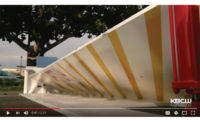The video management systems (VMS) of today are anything but video-only solutions; they often serve as the hub of fully integrated security suites that provide end users with greater choice and functionality. The seemingly endless list of potential integrations includes access control, intrusion detection, point of sale (POS), gunshot detection and much more.
To illustrate the possibilities of these systems, below are four instances of how VMS integrations can be deployed, how they can benefit customers and what integrators learned along the way.
Securing a Utility
What started as an access control project to secure remote substations and other locations to help a national utility comply with new regulations has since grown into a full security deployment for Alarm Systems Inc. of Quincy, Ill. — a process that has been made easy with Honeywell’s MaxPro VMS. Today, the system integrates access control, perimeter detection, intrusion detection, video and other systems.
Prior to the new system’s deployment, these sites had a traditional security system if any at all. Today, that formerly reactive approach has been turned on its ear thanks to VMS automation and video verification that have not only cut down on the number of alarms but allow Alarm Systems to escalate an incident at a moment’s notice in response to a fence-shaking system alert, for example.
“The video aspect plays to efficiency and expediency; it only takes seconds to have eyes on an alert,” says Ronald Haught Jr., president, Alarm Systems. “In the past it took time or law enforcement resources to validate an event, but today with automation and established protocols, it’s much faster to determine whether there’s a threat and what action may be needed.”
The biggest challenge for the integrator was limited if any connectivity at various remote sites. Most had microwave links, fiber or other connection, but regulations made those connections unavailable for Alarm Systems.
“There are stipulations that we can’t ride any of those communication paths,” Haught says. “With the exception of one site where there was limited Wi-Fi available, everything is cellular.”
The project brought about unique challenges, including varying temperatures at substations that range from the Canadian border to Texas, as well as geography and other variables that were at play between individual locations.
“Though these are security integrations, there is no one-size-fits-all option. In these specific environments, we have to take each location and element and evaluate it from a protection standpoint,” Haught says.
While security is the main reason for the integrated system, it is used for much more. For example, the utility is able to remotely perform safety checks, monitor who goes in and out of sites and even change behaviors based on findings from the system.
None of these “extras” were required by the end user but were developed as the project went along. Initially, the system was supposed to be an access control deployment, with integrated video added later because of the need to monitor sites and specific alarms. With Honeywell’s ProWatch and MaxPro, those capabilities have been easy to add along the way.
“It really grew from just doors to an entire security suite,” Haught says.
Delivering End-to-End Protection
God’s Love We Deliver is a New York-based non-profit organization that prepares and delivers nutritious meals to those in need. A dedicated staff and more than 10,000 volunteers serve more than 1.6 million meals per year throughout the city. Boosted by a $5 million donation from fashion designer Michael Kors and with support from New York City and other donors, God’s Love recently expanded its operations and rebuilt its headquarters.
For the new headquarters, the God’s Love team wanted a more intuitive and integrated IP video surveillance and access control system that could help users to easily manage building access, and see what’s happening at a moment’s notice.
Built on Genetec’s Security Center platform, the new system allows security staff to view video of common areas, the new conference floor and rooftop events spaces, volunteer workspace, delivery docks and the building’s perimeter, using Genetec’s Omnicast system. For securing all doors, they use the Synergis access control system from Genetec, which allows the organization to set access on a schedule to accommodate volunteer and staff hours. This has been most helpful for kitchen staff and delivery drivers who begin their workday at 5 a.m. — long before anyone else.
In addition to video and access control, the system also integrates glass-break and intercom systems into Security Center to keep operations fluid. Scheduling of weddings or conference events has also been made easier with the integration, as the God’s Love team can save time by enabling pre-planned event schedules for access control. Additionally, users can view video and respond from an interactive map of the building through Security Center, which has proven to be a good way for the God’s Love security team to handle alarms and manage events.
In all, the ability to streamline operations using the integrated solutions has proven incredibly valuable to the organization.
“Genetec Security Center is a flexible platform that we can adapt to fit our environment. It’s easier for our team to secure our building, allowing staff and volunteers to focus on helping people,” says Pete Tien, network administrator, God’s Love.
Integrating Restaurant Operations
Located in the heart of California’s wine region, San Juan Capistrano-based Tannins Restaurant and Wine Bar installed an upgraded video surveillance system ostensibly to improve security. Built using cameras and other components from Hanwha Techwin America, Ridgefield Park, N.J., the restaurant’s system has also delivered benefits beyond security since its deployment.
The system provides coverage throughout the interior of the restaurant, including a liquor closet where extra alcohol is stored — a location that had become ripe for employee theft and other misuse.
The local office of integration firm Red Hawk Fire and Security, headquartered in Boca Raton, Fla., provided an integrated solution that combines video and POS data with video analytics to ease the previously laborious process of locating specific video following an event or incident.
“Instead of having to rewind through hours of video like we had to do with our old analog system, we were able to identify the important video very quickly,” says Gabriel Sanchez, owner of Tannins Restaurant and Wine Bar.
About a week after the upgraded system was installed, the morning manager arrived to find that a door had been pried open during the night. After police were called, staff quickly and easily pulled video of the incident, which was simplified by the advanced analytic feature of the VMS.
In addition to traditional thefts and security issues, Tannins had also been experiencing loss from the inside. Productivity was also an issue, with some employees simply not doing their jobs.
“Once the new cameras went in, there was a change in productivity. When I log in to the cameras from off-site and see people standing around, I can text the manager to tell them to get to work,” Sanchez says.
“The system has been a great tool to measure productivity and reduce shrinkage,” he adds.
Bringing Citywide Surveillance Together
When Vulcan Technologies Inc. of South Windsor, Conn., was contracted to deploy a citywide surveillance solution for the Hartford Police Department, the integrator anticipated the high potential for the system to grow and deployed Milestone Corporate VMS for just that reason. This turned out to be the case as the system today encompasses approximately 800 cameras from virtually every city department.
“Our intent was to use a system that could leverage as many cameras, analytics and third-party integrations as possible, and the open platform allows us to pick the best of what’s out there,” says Tyler Cullen, director of information technology, Vulcan Technologies.
Among the integrations is ShotSpotter gunshot detection, which allows police to leverage gunshot data coming into the system to coordinate response and drive other actions. GPS data from a detected gunshot translates to a particular geo-fenced area and can direct a PTZ camera to that specific location or preset probable escape route.
In deploying the solution, Vulcan faced two types of challenges: human and technology. On the human side, the issue was that the city was using multiple siloes of video, including police, public works, various city-backed community organizations and more — none of which could be accessed by anyone outside those siloes. Once city and departmental managers saw that Milestone would allow all agencies to access and share video from all systems while delegating permissions as needed, they bought in very quickly, Cullen says.
“Anywhere they put up cameras, the police can access them for real-time enforcement and situational handling. Likewise, the public works department would be able to access cameras for keeping an eye on quality of life issues within the city, illegal dumping, graffiti, trash and other things,” he says. Through converging everybody’s systems together, they ended up saving a lot of money as opposed to if they all tried to eat the whale themselves.”
The technical challenges proved a bit trickier, as Vulcan had to find the best way to get hundreds of video streams from point A to point B without sacrificing quality. Hartford is known for having excellent fiber optics within and between buildings, but not so much on the streets. Working with a variety of stakeholders, however, Vulcan was able to get fiber access at key facilities, then build off those fiber hard points with Fluidmesh.
Through the process, Cullen says Vulcan learned the value of getting things right versus making sales, which has proven valuable throughout the multi-year project.
“You can’t rush the process. It’s more important to get everyone on the same page and build a culture of security first,” Cullen says. “Even if you have to downsize the project just to get it right, that’s the most important thing to do. You really have to foster that mindset early on and get them the right solution to grow.”
For more on video management systems, visit the following articles:
Success is Simple for Integrators Using Today’s Advanced VMS








